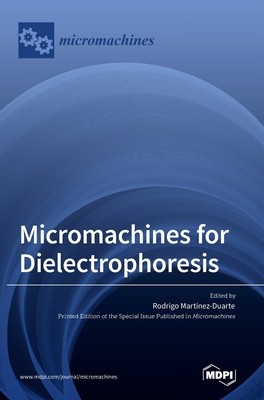
- We will send in 10–14 business days.
- Publisher: MDPI AG
- ISBN-10: 3036543384
- ISBN-13: 9783036543383
- Format: 17 x 24.4 x 1.6 cm, hardcover
- Language: English
- SAVE -10% with code: EXTRA
Micromachines for Dielectrophoresis (e-book) (used book) | bookbook.eu
Reviews
Description
An outstanding compilation that reflects the state-of-the art on Dielectrophoresis (DEP) in 2020. Contributions include: - A novel mathematical framework to analyze particle dynamics inside a circular arc microchannel using computational modeling. - A fundamental study of the passive focusing of particles in ratchet microchannels using direct-current DEP. - A novel molecular version of the Clausius-Mossotti factor that bridges the gap between theory and experiments in DEP of proteins. - The use of titanium electrodes to rapidly enrich T. brucei parasites towards a diagnostic assay. - Leveraging induced-charge electrophoresis (ICEP) to control the direction and speed of Janus particles. - An integrated device for the isolation, retrieval, and off-chip recovery of single cells. - Feasibility of using well-established CMOS processes to fabricate DEP devices. - The use of an exponential function to drive electrowetting displays to reduce flicker and improve the static display performance. - A novel waveform to drive electrophoretic displays with improved display quality and reduced flicker intensity. - Review of how combining electrode structures, single or multiple field magnitudes and/or frequencies, as well as variations in the media suspending the particles can improve the sensitivity of DEP-based particle separations. - Improvement of dielectrophoretic particle chromatography (DPC) of latex particles by exploiting differences in both their DEP mobility and their crossover frequencies.
EXTRA 10 % discount with code: EXTRA
The promotion ends in 9d.04:14:04
The discount code is valid when purchasing from 10 €. Discounts do not stack.
- Publisher: MDPI AG
- ISBN-10: 3036543384
- ISBN-13: 9783036543383
- Format: 17 x 24.4 x 1.6 cm, hardcover
- Language: English English
An outstanding compilation that reflects the state-of-the art on Dielectrophoresis (DEP) in 2020. Contributions include: - A novel mathematical framework to analyze particle dynamics inside a circular arc microchannel using computational modeling. - A fundamental study of the passive focusing of particles in ratchet microchannels using direct-current DEP. - A novel molecular version of the Clausius-Mossotti factor that bridges the gap between theory and experiments in DEP of proteins. - The use of titanium electrodes to rapidly enrich T. brucei parasites towards a diagnostic assay. - Leveraging induced-charge electrophoresis (ICEP) to control the direction and speed of Janus particles. - An integrated device for the isolation, retrieval, and off-chip recovery of single cells. - Feasibility of using well-established CMOS processes to fabricate DEP devices. - The use of an exponential function to drive electrowetting displays to reduce flicker and improve the static display performance. - A novel waveform to drive electrophoretic displays with improved display quality and reduced flicker intensity. - Review of how combining electrode structures, single or multiple field magnitudes and/or frequencies, as well as variations in the media suspending the particles can improve the sensitivity of DEP-based particle separations. - Improvement of dielectrophoretic particle chromatography (DPC) of latex particles by exploiting differences in both their DEP mobility and their crossover frequencies.


Reviews